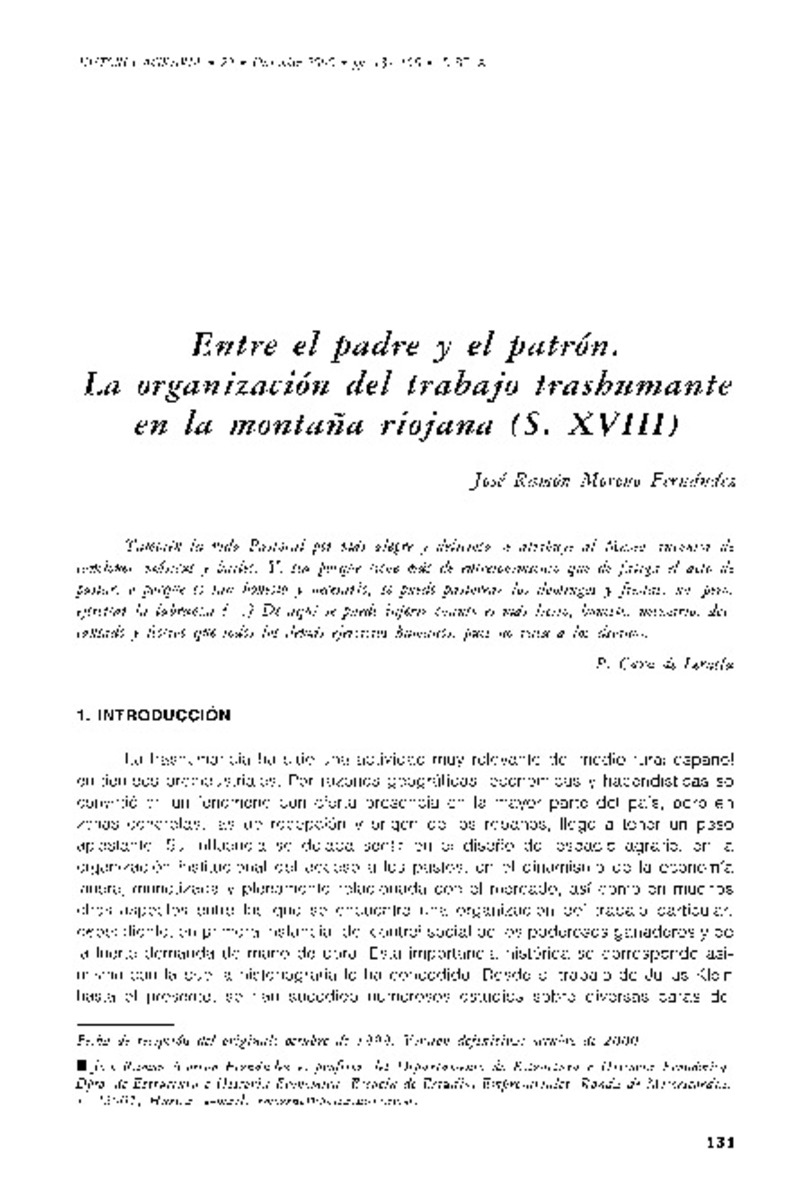Mostrar el registro sencillo del ítem
Entre el padre y el patrón. La organización del trabajo trashumante en la montaña riojana (S. XVIII)
| dc.contributor.author | Moreno Fernández, José Ramón | |
| dc.date.accessioned | 2015-07-31T10:32:08Z | |
| dc.date.available | 2015-07-31T10:32:08Z | |
| dc.date.issued | 2000-12 | |
| dc.identifier.issn | 1139-1472 | |
| dc.identifier.uri | http://hdl.handle.net/10234/129846 | |
| dc.description.abstract | En este trabajo se estudia una fracción del mundo de montaña preindustrial, la relacionada con los pastores trashumantes. Asalariados y dependientes del mercado de trabajo, el enfoque elegido trata de comprender la lógica de una organización del trabajo compleja que se puede analizar como resultado de un dilatado conjunto de interacciones, Los objetivos serán dos: por un lado, comprender mejor el oficio pastoril en sus aspectos económicos y sociales, y por otro, entender la trascendencia que tenía el mercado de trabajo en la reproducción de los hogares serranos, Se utilizan dos perspectivas complementarias, Primera, observar el trabajo de los pastores como un artefacto institucional orientado a la captación de excedente por parte de los ganaderos, que se aprovechaban de su peso social para obtener trabajo dócil y barato Segunda, observar el pastoreo como un fenómeno familiar, que se complementaba con las otras dedicaciones pluriactivas características de una economía de montaña. | ca_CA |
| dc.description.abstract | This article studies one aspect of the pre-industrial world of the uplands, namely the labour organisation of transhumant shepherds, These were paid workers who depended on the labour market. The approach of this article is to try to understand the logic of a complex labour organization which can be analyzed as the result of a long-drawn out series of interactions. There are two objectives: on the one hand, to reach a better understanding of economic and social aspects of the work of the shepherd, and on the other hand, to understand the importance of the labour market in the social reproduction of peasant holds Two complementary perspectives are accomplished. Firstly, the work of the shepherds is viewed as an institutional mechanism intended to accumulate profit on the part of the livestock farmers. who took advantage of their social position to obtain docile and cheap labour. Secondly, shepherding is identified as a family-based phenomenon complemented with the other varied work typical of an upland economy. | ca_CA |
| dc.format.extent | 28 p. | ca_CA |
| dc.format.mimetype | application/pdf | ca_CA |
| dc.language.iso | spa | ca_CA |
| dc.publisher | Sociedad Española de Historia Agraria (SEHA) | ca_CA |
| dc.relation.isPartOf | Historia agraria: Revista de agricultura e historia rural, nº 22, p. 131-158 | ca_CA |
| dc.rights | © SEHA | ca_CA |
| dc.rights.uri | http://rightsstatements.org/vocab/InC/1.0/ | * |
| dc.subject | economía de montaña | ca_CA |
| dc.subject | trashumancia | ca_CA |
| dc.subject | pastoreo | ca_CA |
| dc.subject | pluriactividad | ca_CA |
| dc.subject | organización del trabajo | ca_CA |
| dc.subject | mountain economy | ca_CA |
| dc.subject | transhumance | ca_CA |
| dc.subject | shepherding | ca_CA |
| dc.subject | multi-activity | ca_CA |
| dc.subject | agrarian labour organization | ca_CA |
| dc.title | Entre el padre y el patrón. La organización del trabajo trashumante en la montaña riojana (S. XVIII) | ca_CA |
| dc.type | info:eu-repo/semantics/article | ca_CA |
| dc.rights.accessRights | info:eu-repo/semantics/openAccess | ca_CA |
| dc.relation.publisherVersion | http://historiaagraria.com/info_articulo.php?id=259 | ca_CA |







